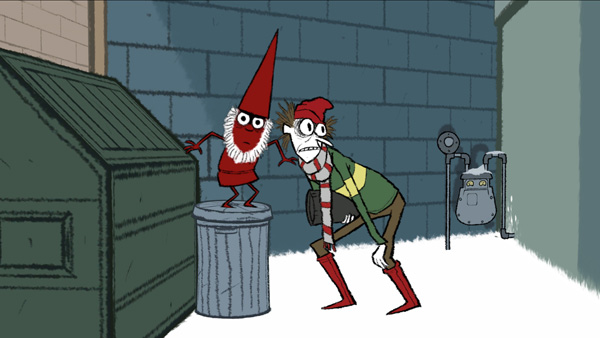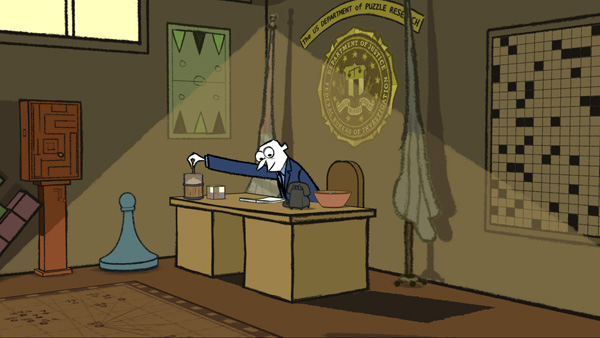 I recently had the chance to visit the Telltale Games San Rafael studio and spend some time with their upcoming story-based puzzle game Puzzle Agent. In the game, you’ll play the role of Nelson Tethers, the country’s preeminent (and only) agent of the FBI Puzzle Research Division. An incident at the eraser factory in Scoggins, Minnesota has brought production of erasers to a halt. Since this particular factory supplies erasers to the White House, the foundations of democracy hang in the balance until they are able to replenish their supply. All inquiries about the factory’s closing have resulted in responses in the form of puzzles, so Nelson is sent to investigate the incident and unearths a twisted tale of what’s really happening in Scoggins, Minnesota.
I recently had the chance to visit the Telltale Games San Rafael studio and spend some time with their upcoming story-based puzzle game Puzzle Agent. In the game, you’ll play the role of Nelson Tethers, the country’s preeminent (and only) agent of the FBI Puzzle Research Division. An incident at the eraser factory in Scoggins, Minnesota has brought production of erasers to a halt. Since this particular factory supplies erasers to the White House, the foundations of democracy hang in the balance until they are able to replenish their supply. All inquiries about the factory’s closing have resulted in responses in the form of puzzles, so Nelson is sent to investigate the incident and unearths a twisted tale of what’s really happening in Scoggins, Minnesota.
The art style in Puzzle Agent is directly inspired by the work of Graham Annable, who is responsible for creating the Grickle comics and animated shorts (which can be seen at his YouTube channel). Puzzle Agent isn’t exactly a Grickle video game, but it does use the same type of characters, animation, and dark humor that the series is known for. Telltale Games producer and designer of Puzzle Agent Mark Darin engrossed himself in the world of Grickle before writing the story for the game, and Graham did the storyboards for characters and locations. For fans of Grickle, it’s very much a Grickle game, but is not directly branded as such and doesn’t require any previous knowledge of that series to enjoy the minimalist style and twisted sense of humor in Puzzle Agent.
Puzzle Agent can be compared to games like Professor Layton or The Jim and Frank Mysteries in that you’re on an adventure and must use solving puzzles to unravel the story and progress through the game, but it makes some smart changes to the formula that sets it apart from similar games. Most notable is that all of the dialogue in the game is voiced, which gives the characters a ton of personality that couldn’t be conveyed through text alone. Also, whereas adventure games are traditionally set against 2D backgrounds, Puzzle Agent renders the backgrounds in 3D. The game still has that 2D animated look that it sets out to achieve, but the 3D backgrounds allow for more dramatic camera movements and transitions between scenes.


Another smart design choice is in the way you interact with the environments. Tapping on the screen causes a ring to emanate from the point where you touch, and if there is anything interactive within that radius a small icon will show up. This allows you to inspect large areas without scouring every inch of the screen, or as Mark Darin calls it, “pixel hunting”. As someone who hates to miss anything in an adventure game, and who tirelessly hunt-and-pecked for every coin in Professor Layton, I really appreciate this mechanic. Despite being a multiplatform release, Mark has said that Puzzle Agent was designed from the onset with touch interface in mind, and it really shows.
Puzzle Agent was released for Mac and PC last month, but is shaping up very nicely for its iPhone and iPad release. It looks and plays like a dream on the iPad, and even makes the transition to the smaller screen of the iPhone rather well. Some textures need to be cleaned up a bit on the iPhone version due to being shrunk down to a smaller size, but overall both versions are nearly complete. Telltale expects to be submitting any day now, and hopes to have the game released before the end of August, although that can largely depend on Apple’s approval length.
After trying out the game at their offices, I picked up the game for my Mac and have been enjoying it a lot so far. If you’re as impatient as I am, you can get Puzzle Agent right now from the Telltale Games webstore or pick it up on Steam. Otherwise be on the lookout for Puzzle Agent on your iPad, iPhone, or iPod touch in the next couple of weeks and expect a full review then as well.
